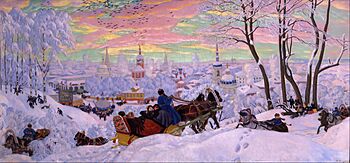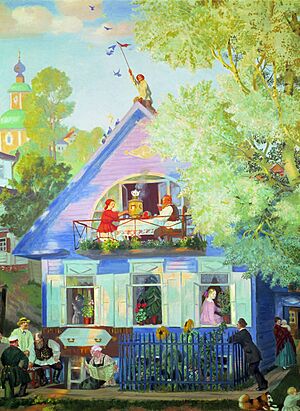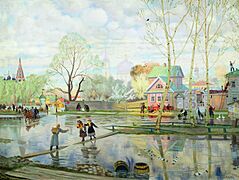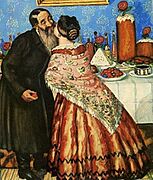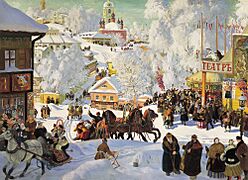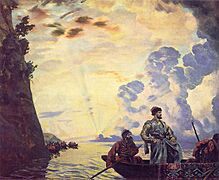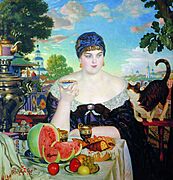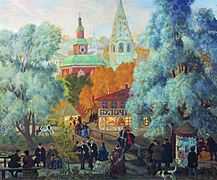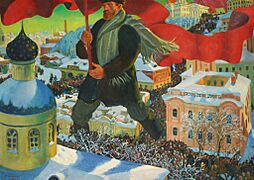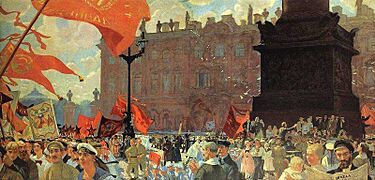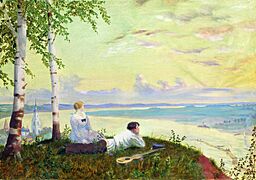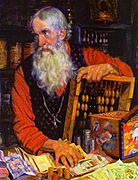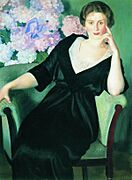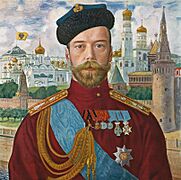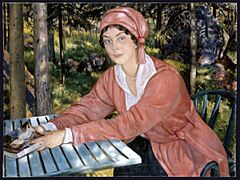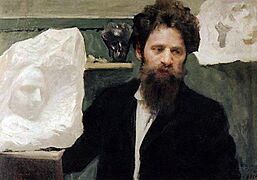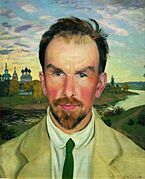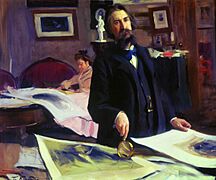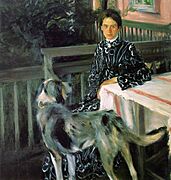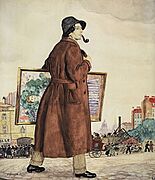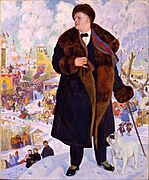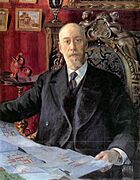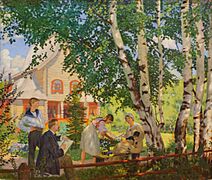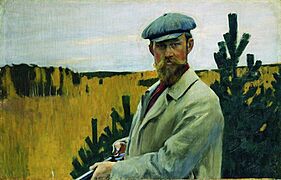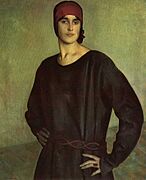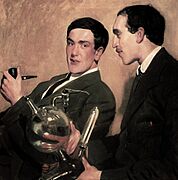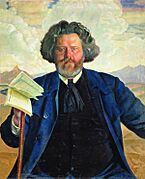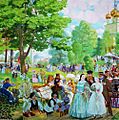Boris Kustodiev facts for kids
Boris Mikhaylovich Kustodiev (born March 7, 1878 – died May 28, 1927) was a famous Russian painter and stage designer. He created many colorful and lively artworks, often showing the everyday life and traditions of Russia.
Quick facts for kids
Boris Kustodiev
|
|
|---|---|
| Борис Кустодиев | |

Self-portrait in front of Troitse-Sergiyeva Lavra, 1912, Uffizi
|
|
| Born |
Boris Mikhaylovich Kustodiev
7 March 1878 Astrakhan, Astrakhan Governorate, Russian Empire
|
| Died | 28 May 1927 (aged 49) Leningrad, Russian SFSR, Soviet Union (now Saint Petersburg)
|
| Occupation | Painter Stage designer |
Contents
Early Life and Art Studies
Boris Kustodiev was born in Astrakhan, Russia, in 1878. His father was a professor, but he passed away when Boris was young. His mother then had to take care of the family. They rented a small part of a wealthy merchant's house. This is where Boris first saw the lively life of the merchant class. He later used these memories in many of his paintings.
From 1893 to 1896, Boris took art lessons in Astrakhan. Later, from 1896 to 1903, he studied at the Imperial Academy of Arts in Saint Petersburg. He learned from famous artists like Ilya Repin, who was one of his teachers. Repin thought Boris was a very talented and serious artist.
Boris helped Repin paint a large picture for the 100th anniversary of the State Council. This was a big and important project. Boris also painted portraits of his friends and other artists during this time. In 1903, he married Julia Proshinskaya.
Travels and Inspirations
In 1904, Boris traveled to France and Spain with a special grant from the Imperial Academy of Arts. He also visited Italy, Austria, and Germany in later years. Even though he saw many beautiful places, he always felt a strong pull back to his home country, Russia. After five months in France, he was very happy to return to "our blessed Russian land."
Artistic Career
The Russian Revolution of 1905 greatly affected Boris. He started drawing for satirical magazines like Zhupel (Bugbear). Around this time, he met other innovative Russian artists from the Mir Iskusstva (World of Art) group. He joined them in 1910 and showed his art in their exhibitions.
In 1905, Boris also began illustrating books. He illustrated many classic Russian stories, including works by Nikolai Gogol and Leo Tolstoy. His illustrations for Nikolai Leskov's stories were especially well-known.
In 1909, he became a member of the Imperial Academy of Arts. Sadly, he became very ill with a spine disease. He went to Switzerland for treatment, but he missed Russia greatly. Even while sick, he continued to paint Russian themes. In 1918, he painted The Merchant's Wife, which became one of his most famous works.
By 1916, Boris could no longer walk. He wrote, "Now my whole world is my room." Despite his illness, he remained cheerful and lively. His paintings are full of bright colors and happy scenes, which makes it hard to imagine his physical suffering. Many of his paintings, like Pancake Tuesday/Maslenitsa (1916), were painted from his memories of childhood.
After the Russian Revolution of 1917, Boris continued to work with great energy. He created drawings for calendars, book covers, and even sketches for street decorations. His covers for journals were very popular because they were so vivid. He also made lithography prints.
Stage Design Work
Boris Kustodiev was also very good at designing sets for plays. He started working in the theater in 1911. His first success was designing the sets for Alexander Ostrovsky's play An Ardent Heart. People loved his work, and he received many more requests. In 1913, he designed sets and costumes for a play at the Moscow Art Theatre.
He was especially talented at designing for Ostrovsky's plays, which often showed provincial life and the world of merchants. This was a subject Boris knew well from his own childhood, so he worked quickly and easily on these stage sets.
In 1923, Boris joined the Association of Artists of Revolutionary Russia. He continued to paint, make engravings, illustrate books, and design for the theater until he passed away from tuberculosis on May 28, 1927, in Leningrad.
Selected Works
-
Bolshevik (1920)
- Portraits
-
Tsar Nicholas II (1915)
-
Shalyapin or Portrait of Chaliapin (1922)
-
Portrait of Nikolai von Meck
-
Maximilian Voloshin (1924)
Images for kids
See also
- List of Russian artists



